Third Generation Gangs Strategic Note No. 46: Los Angeles Strike Force Investigation into Alleged Weapons Trafficking Organization Providing Weapons and Ammunition to the Cártel Jalisco Nueva Generación (CJNG)
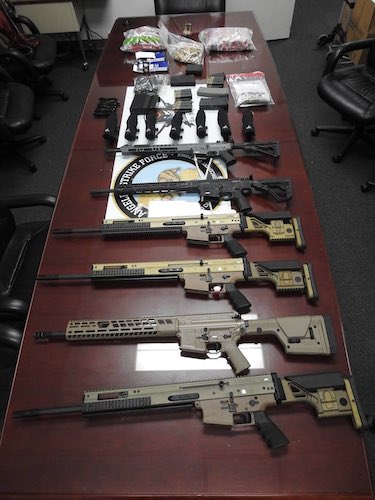
Third Generation Gangs Strategic Note No. 46: Los Angeles Strike Force Investigation into Alleged Weapons Trafficking Organization Providing Weapons and Ammunition to the Cártel Jalisco Nueva Generación (CJNG)
John P. Sullivan, Nathan P. Jones, and Robert J. Bunker
A Federal Grand Jury in Los Angeles named six defendants in a weapon smuggling organization in a 23-count indictment alleging that the cell conspired to violate federal export laws to provide weapons and ammunition to Cártel Jalisco Nueva Generación (CJNG) operatives in Mexico. The indictment charged six individuals and asserts that they are members of a group known as the Santillan gun trafficking organization.

Weapons Seized During the Operation Semper Infidelis Gun Trafficking Investigation. US Attorney Los Angeles (Central District of California), @USAO_LosAngeles. Twitter. 24 January 2022.
Key Information: Matthew Ormesth, “Whittier man is charged with smuggling guns destined for drug traffickers in Mexico.” Los Angeles Times. 24 January 2022, https://www.latimes.com/california/story/2022-01-24/whittier-man-charged-with-smuggling-guns-for-mexican-drug-cartel:
Federal authorities charged a Whittier man with directing a conspiracy to ship weaponry and ammunition to members of the Jalisco New Generation Cartel, a drug trafficking group that law enforcement officials describe as one of the most powerful in Mexico.
Marco Antonio Santillan Valencia, 51, was charged with conspiring to evade restrictions on the export of firearms, conspiring to launder money and possessing ammunition as a felon.
Santillan and his codefendants, including his son Marco Santillan Jr., 29, are accused of buying guns, ammunition and firearm components in Nevada, Oregon, Nebraska and Arizona and arranging to smuggle them into Mexico. The weaponry was purchased with the proceeds of drug sales, prosecutors charged.
An indictment, returned in December and unsealed last week, offers a sense of the alleged operation’s scope: Stopped by law enforcement in San Bernardino County, Santillan Jr. and two others were found to be transporting 64,400 rounds of ammunition, 20 50-round ammunition belts, rifle scopes, $52,471 in cash and $10,000 in money orders, the document says.
Key Information: “Former Marine and 5 others accused of gun-smuggling to Mexican drug cartel.” City News Service via ABC 10 News (San Diego). 24 January 2022, https://www.10news.com/news/national/6-charged-with-bid-to-smuggle-arsenal-to-mexican-drug-cartel:
LOS ANGELES (CNS) — A former U.S. Marine from Whittier is facing federal charges alleging he led a six-man scheme to smuggle weapons and ammunition to one of the most feared transnational drug cartels in Mexico, federal prosecutors announced Monday.
Marco Antonio Santillan Valencia, 51, and three other alleged members of the operation were arrested last week in Southern California as part of a federal investigation dubbed Operation Semper Infidelis, a play on the Marines’ famous motto, according to the U.S. Attorney’s Office.
In conjunction with the arrests, Los Angeles authorities unsealed a 23-count federal court indictment charging the six defendants with conspiring to violate federal export laws by illegally bringing the weapons and ammunition to cartel operatives in Mexico.
Key Information: “Indictment Names Six in Scheme to Provide High-Powered Firearms and Huge Quantities of Ammunition to Mexican Drug Cartel.” Press Release. Los Angeles: United States Attorney’s Office, Central District of California. 24 January 2022, https://www.justice.gov/usao-cdca/pr/indictment-names-six-scheme-provide-high-powered-firearms-and-huge-quantities:
LOS ANGELES – A federal grand jury indictment alleging a scheme to smuggle weapons and ammunition to one of the world’s most violent and dangerous transnational criminal organizations has led to the arrest of four defendants, the Justice Department announced today.
The arrests on January 19 are the result of Operation Semper Infidelis, a Los Angeles Strike Force investigation that targeted a domestic weapons trafficking organization that provided firearms and ammunition to the Cártel Jalisco Nueva Generación (CJNG), one of the largest and most violent drug cartels in Mexico. In conjunction with the arrests, authorities unsealed a 23-count indictment that charges six defendants with conspiring to violate federal export laws by illegally bringing the weapons and ammunition to CJNG operatives in Mexico.
The indictment alleges that a Whittier man led the gun trafficking organization that used narcotics proceeds to purchase assault rifles, hundreds of thousands of rounds of assault rifle ammunition, and numerous machine gun parts and accessories – some of which were smuggled into Mexico, mostly since the beginning of the COVID-19 pandemic.
Key Information: “Whittier man, 5 others charged in scheme to smuggle weapons to Mexican drug cartel.” Eyewitness News (ABC 7 Los Angeles). 25 January 2022, https://abc7.com/weapons-smuggling-scheme-mexico-drug-cartel/11508264/:
The men used drug money to purchase legally-available weapons in Oregon and Nevada and ammunition from several states, sometimes ordering pallets of bullets for delivery to a “stash location” in Nevada, according to a statement from the U.S. attorney’s office.
The operation began in March 2020 and lasted about a year, during which some items were sent to Mexico while authorities seized others, including assault rifles and several hundred thousand rounds of ammunition, including some 10,000 rounds of .50-caliber armor piercing incendiary ammunition obtained in Arizona, authorities said.
Also seized were assault rifle parts and kits to assemble miniguns, which are six-barrel rotary machine gun capable of firing up to 6,000 rounds per minute, authorities said.
“This case alleges a scheme to provide military-grade firepower to a major drug trafficking organization that commits unspeakable acts of violence in Mexico to further its goal of flooding the United States with dangerous and deadly narcotics,” U.S. Attorney Tracy L. Wilkison said in a statement.
Key Information: Nathaniel Janowitz, “How to Get Busted for Trafficking Guns to Cartels: Brag About It on Facebook.” Vice. 26 January 2022, https://www.vice.com/en/article/jgmdpg/how-to-get-busted-for-trafficking-guns-to-cartels-brag-about-it-on-facebook:
In a series of particularly poor decisions in May 2020, prosecutors claim the younger Santillan boasted about his connection to the CJNG. Founded by wanted fugitive Nemesio Oseguera, alias El Mencho, the CJNG is considered one of the largest and most dangerous criminals groups in Mexico known for its impressive arsenal of military-grade weapons.
On May 26, Santillan Jr. allegedly sent two videos to an unnamed person over Facebook messenger showing around 50 rifles, followed by a third video of himself holding one. Authorities alleged he used “coded language” to tell the individual that the guns were going to Mexico.
That same day, Santillan Jr. bragged to a different person over Facebook messenger that members of “Mencho’s cartel… are buying everything,” allegedly referring to the firearms and accessories.
Santillan Jr. continued his flurry of Facebook messages by sending yet another video to a third individual of himself holding a fanned stack of $100 bills and told the person that his sale of firearms to the CJNG was profitable, according to the indictment.
Third Generation Gangs Analysis
The Los Angeles Times reported, “the guns and ammunition were said by law enforcement officials to be bound for members of the Jalisco New Generation Cartel, known by its Spanish initials, CJNG. Prosecutors cited a Facebook message in which Santillan Jr. allegedly said that ‘Mencho’s cartel’ was “buying everything.”[1]
The investigation known as Operation Semper Infidelis was conducted by the Los Angeles Strike Force. The LA Strike Force is led by the Federal Bureau of Investigation (FBI), Drug Enforcement Administration (DEA), and US Attorney’s Office (USAO). Other members include the Los Angeles Police Department (LAPD), Homeland Security Investigations (HSI), and US Marshals Service (USMS).[2]
Six defendants are named in the indictment:
- Marco Antonio Santillan Valencia, 51, of Whittier, the alleged leader of the organization that obtained and supplied weapons, firearms parts and ammunition to the CJNG;
- Anthony Marmolejo Aguilar, 30, of Whittier, who is currently in state custody on separate charges in North Carolina;
- Marco Santillan Jr., 29, of Pahrump, Nevada, who is the son of the alleged leader of the ring and who was arrested in Oregon;
- Michael Diaz, 33, of Moreno Valley;
- Luis De Arcos, 51, of Midway City; and
- Rafael Magallon Castillo, 34, of Oceano, who is a fugitive believed to be in Mexico.[3]
Weapons and ammunitions seized include: “six assault rifles, over 250,000 rounds of assault rifle ammunition, over $300,000 worth of weapons parts and kits to assemble several “mini-guns” – six-barrel rotary machine guns capable of firing up to 6,000 rounds per minute,” as well as, “.50-caliber armor piercing incendiary ammunition and .223-caliber ammunition.”[4] The mini guns seizure is of particular concern because if they has been fielded by the CJNG they would have provided effective anti-air defense capabilities for the cartel’s commando units formed around IAFVs (Improvised Armored Fighting Vehicles).
The Los Angeles Times reported that:
Authorities in Los Angeles (LA) warned two years ago that Oseguera’s organization was using drug proceeds to buy weapons in the United States, then smuggling the guns and ammunition to Mexico. Federal prosecutors charged four men at the time with conspiring to buy assault weapons; one of the defendants, a cook at a Santa Ana seafood restaurant, was said to have asked a DEA informant about the viability of buying several hundred AK-47s and AR-15s.[5][6]
Social Network Analysis of the Santillan Gun Smuggling Cell
The indictment of the alleged CJNG gun smuggling cell led by Santillan had significant relational data the authors of this note were able to code into two useful networks: 1) a person-to-person network, and 2) a person to criminal count network, which included the weapons and ammunition associated with the count. Court documents indicated that the alleged conspiracy began March 2020 and lasted about a year.[7] It should be noted that indictments are accusations, and the accused are innocent until proven guilty. Before we delve into these co-offender networks, a brief discussion of the social network analysis (SNA) literature is in order.
SNA on Criminal Documents
Social Network Analysis has increasingly been applied to law enforcement intelligence and scholarly criminology work.[8] There have been significant recent SNA studies on Mafias,[9] drug networks,[10] dark network social media/information warfare structures,[11] and human trafficking networks.[12] Berlusconi demonstrated that arrest warrant data such as an indictment can be representative of the key players of an illicit network.[13]
Fewer SNA studies have been conducted on gun and firearms trafficking networks. Leuprecht and Aulthouse are a notable exception having conducted an SNA on six cases of gun smuggling networks and developed important hypotheses. One of these is that given the legal nature of the US gun market, the structure of smuggling networks is likely to have a “proliferation” of “simple” networks.[14] Their findings are consistent with the structure of the Santillan cell network, which is small (6-7 members) and took few compartmentation steps or “security” measures in exchange for the “efficiency” of communication and collaboration on criminal activities.[15]
Social Network Analysis Case Study: The Santillan Cell
The authors coded the indictment of the Santillan cell into two networks and analyzed the networks in Netdraw a program built into UCINET.[16] It should be noted that not all individuals in the network were wittingly a part of the network. For example, a gun store employee is not committing a crime if he/she does not know the customer intends to sell the weapon to a criminal organization. Also, the person(s) who was the recipient ofFacebook messages from Santillan Jr. bragging about the guns and illegal sales was also not necessarily part of the network.
We chose to include these individuals because they were critical to the functioning or disruption of the network according to law enforcement court and media documents. Illicit networks use US legal gun stores to funnel guns into Mexico through straw purchasers.[17] The gun stores are not necessarily committing a crime, but are an unwitting, yet critical source for the network. Likewise, Santillan Jr.’s unwise bragging about his criminal exploits to an unknown individual—possibly multiple, though the indictment did not specify—may have assisted law enforcement in disrupting the smuggling cell and understanding the true buyer, the CJNG led by “El Mencho.” For a discussion of coding decisions and implications see Note 18.[18]

Figure 1. Santillan-CJNG Gun Smuggling cell Key Players Network.[19]
In Figure 1 above we can see the ties or edges are sized by “weight” or the number of operational connections between nodes. Santillan had significant ties (Overt acts typically phone calls and messages) to his son Santillan Jr. Santillan often directed Santillan Jr. to send pictures of the weapons and ammunition once procured. This resulted in many communications and the increased weight we see here. This is consistent with the SNA literature on kinship ties in dark networks, wherein terrorists/traffickers are more likely to work with those they have kinship ties to as well.[20]. For more analysis on the network topography and measures of the network see Note 21.[21]
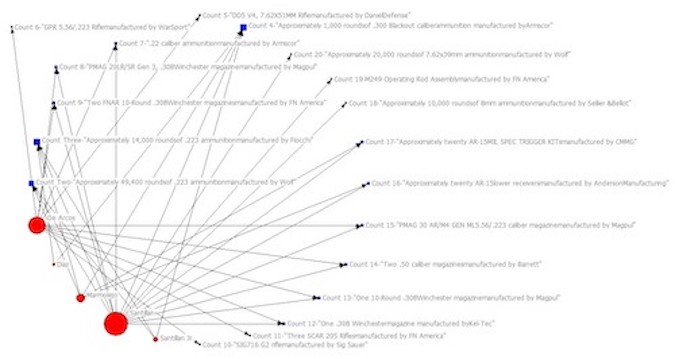
Figure 2. CJNG Gun Smuggling Cell Person to Criminal Count/Weapons and Ammo Network (Circle Layout, Nodes sized on Degree Centrality).
In Figure 2, above we can see the accused in red with their nodes sized on degree centrality: the larger the node the more ties they have to the various criminal counts. One of the most fascinating aspects of Figure 2 is that De Arcos appears highly central in this network but does not in the Figure 1 network. In other words, he suffered one of the highest numbers of criminal counts but was not well-connected to others in the network. This is consistent with the results of a famous study on price-fixing, which showed that those who had high degree centrality were more likely to be found guilty (often not top-level executives but lower-level manager network members).[22] In Figure 1 we see De Arcos’ ties are to Marmolejo and a low weight tie to Santillan. De Arcos appears to have been low level in the cell, but with very high criminal exposure, despite limited network contacts. Santillan however has the highest degree centrality in both networks. Deeply involved in all aspects of cell operations, he had significant person-to-person contacts and the highest number of criminal counts and is thus unsurprisingly the lead defendant.
CJNG Ammunition and Weapons Preferences
From Table 1, we can quickly discern that .223 rounds, which are used in AR-15 style rifles were most prevalent. Table 1 below quantifies the fact derived from data on counts 2-20 and in the overt acts of the indictment.
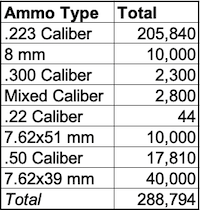
Table 1. Rounds of Ammunition
Table 1 depicts ammunition rounds by type. Here we see the majority of the ammunition was .223 rounds that would be associated with AR-15 style rifles. Figure 3 shows the ammunition break down by percentage. 71.28% of the ammunition this cell focused on was AR-15 style, with AK style accounting for 13.85%.
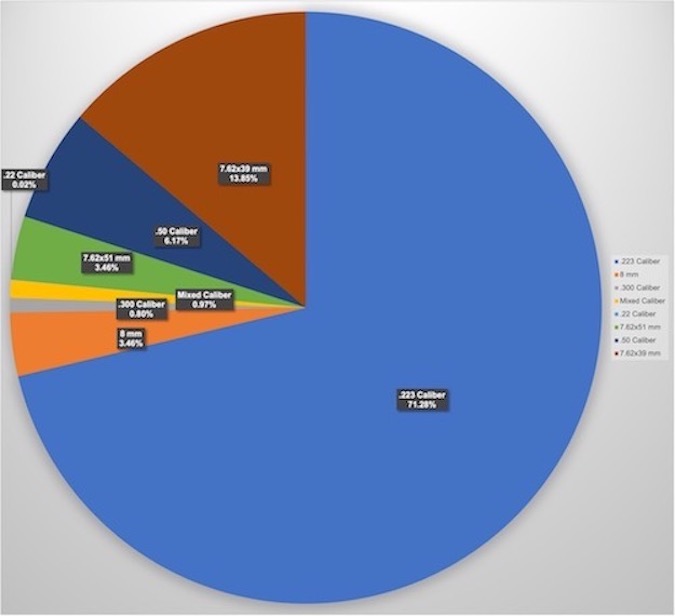
Figure 3. CJNG Gun Smuggling Cell Rounds of Ammunition by Type
From Table 1 and Figure 3, we can see there was a preference for AR-15 style rifles and ammunition. This suggests the CJNG prefers this style of small arms over the AK-47 in general. This is consistent with previous reporting on the CJNG that showed, the organization manufactured its own AR-15s in Mexico in clandestine facilities.[23]
It should be noted that 6.17% of the ammunition acquired by this cell was .50 caliber which is known for high powered sniper rifles, among other weapons. Thus, this ammunition while only 6.17% of the rounds acquired by the cell, may have outsized tactical and operational significance for the CJNG in Mexico, given its capacity to be used in targeted killings, anti-vehicular engagements, and to literally penetrate through the walls of police stations.
Conclusion
The Santillan CJNG gun smuggling cell can be viewed as a hub network with Santillan, his son, and Marmolejo having high degree and betweenness centrality in the network. It was a simple network—as predicted by Leuprecht and Andrew Aulthouse (2014) in environments where guns are legal—with few security measures in place internally.[24] Future research could incorporate new data on this network as the case progresses through the courts. It could also expand the number of cases, to test the hypotheses and findings of Leuprecht and Aulthouse in the US-Mexico context in addition to looking at the other side of the border in Mexico where guns are highly illegal, but rule of law is very weak. Further, future research could code the stash houses and other locations used in the commissioning of firearms trafficking to see what insight can be gleaned from a network connecting persons to places critical to the functioning of the network.
The analysis depicted a fairly dense network, concentrated on a few individuals, with few security measures, and a preference for AR-15 style ammunition and weapons. This gives us insight into the preferred arsenal of the CJNG. The CJNG is widely considered the most para-militarized cartel in Mexico with tactics derived from many previous groups through intermingling members.[25] The likely CJNG preference for AR-15s raises an interesting question for future research. Does the CJNG prefer this weapon for its function and utility? Or is this the most available weapon due to the easy access of the US legal market and the preferences of buyers there? More importantly, this case, when viewed in context of previous prosecutions confirms an active small arms trade in Los Angeles with connections to the CJNG.[26]
Sources
“Former Marine and 5 others accused of gun-smuggling to Mexican drug cartel.” City News Service via ABC 10 News (San Diego). 24 January 2022, https://www.10news.com/news/national/6-charged-with-bid-to-smuggle-arsenal-to-mexican-drug-cartel.
“Indictment Names Six in Scheme to Provide High-Powered Firearms and Huge Quantities of Ammunition to Mexican Drug Cartel.” Press Release. Los Angeles: United States Attorney’s Office, Central District of California. 25 January 2022, https://www.justice.gov/usao-cdca/pr/indictment-names-six-scheme-provide-high-powered-firearms-and-huge-quantities.
Nathaniel Janowitz, “How to Get Busted for Trafficking Guns to Cartels: Brag About It on Facebook.” Vice. 26 January 2022, https://www.vice.com/en/article/jgmdpg/how-to-get-busted-for-trafficking-guns-to-cartels-brag-about-it-on-facebook.
Matthew Ormesth, “Whittier man is charged with smuggling guns destined for drug traffickers in Mexico.” Los Angeles Times. 24 January 2022, https://www.latimes.com/california/story/2022-01-24/whittier-man-charged-with-smuggling-guns-for-mexican-drug-cartel.
United States v. Santillan, et el. Indictment, United States District Court, Central District of California, CR 2:-cr-00588-JFW, filed 21 December 2021, https://s3.documentcloud.org/documents/21186184/cjng-california-gun-trafficking-indictment.pdf.
“Whittier man, 5 others charged in scheme to smuggle weapons to Mexican drug cartel.” Eyewitness News(ABC 7 Los Angeles). 25 January 2022, https://abc7.com/weapons-smuggling-scheme-mexico-drug-cartel/11508264/.
Endnotes
[1] Matthew Ormesth, “Whittier man is charged with smuggling guns destined for drug traffickers in Mexico.” Los Angeles Times. 24 January 2022, https://www.latimes.com/california/story/2022-01-24/whittier-man-charged-with-smuggling-guns-for-mexican-drug-cartel.
[2] “Indictment Names Six in Scheme to Provide High-Powered Firearms and Huge Quantities of Ammunition to Mexican Drug Cartel.” Press Release. Los Angeles: United States Attorney’s Office, Central District of California. 25 January 2022, https://www.justice.gov/usao-cdca/pr/indictment-names-six-scheme-provide-high-powered-firearms-and-huge-quantities.
[3] Ibid.
[4] Ibid.
[5] Op. cit., Ormest at Note 1.
[6] On earlier indications of LA area gun smuggling activity allegedly tied to the CJNG, see Matthew Ormseth, “Federal officials announce crackdown on violent drug cartel.” Los Angeles Times. 11 March 2020, https://www.latimes.com/california/story/2020-03-11/federal-officials-announce-cartel-crackdown.
[7] Ana Rodriguez, “Four arrested in Mexican cartel weapon smuggling operation out of Pahrump, Whittier.” 8 News Now Las Vegas. 26 January 2022, https://www.8newsnow.com/news/local-news/four-arrested-in-mexican-cartel-weapon-smuggling-operation-out-of-pahrump-whittier/.
[8] Nathan P. Jones, Layne W. Dittmann, Jun Wu, and Tyler Reese, “A Mixed Methods Social Network Analysis of a Cross-Border Drug Network: The Fernando Sanchez Organization (FSO).” Trends in Organized Crime. Vol. 23, no. 2. 2020: pp. 154–182, https://doi.org/10.1007/s12117-018-9352-9; David Bright, Russell Brewer, and Carlo Morselli, “Using Social Network Analysis to Study Crime: Navigating the Challenges of Criminal Justice Records,” Social Networks. Vol. 66. 2021: pp. 50–64, https://doi.org/10.1016/j.socnet.2021.01.006; and Malcolm K. Sparrow, “The Application of Network Analysis to Criminal Intelligence: An Assessment of the Prospects.” Social Networks. Vol. 13, no. 3. 1991: pp. 251–274, https://scholar.harvard.edu/files/msparrow/files/application_of_network_analysis_to_criminal_intelligence-social_networks-1991.pdf.
[9] Francesco Calderoni, “The Structure of Drug Trafficking Mafias: The ‘Ndrangheta and Cocaine.” Crime, Law and Social Change. Vol. 58, no. 3. 2012: 321–349, http://dx.doi.org/10.1007/s10611-012-9387-9.
[10] Gisela Bichler, Aili Malm, and Tristen Cooper, “Drug Supply Networks: A Systematic Review of the Organizational Structure of Illicit Drug Trade.” Crime Science. Vol. 6, no. 1. 2017, https://crimesciencejournal.biomedcentral.com/articles/10.1186/s40163-017-0063-3 and Francisco Sollano Jr, “A social network analysis of Genaro García Luna and his alleged ties to the Sinaloa Cartel.” Small Wars Journal.11 January 2021, https://smallwarsjournal.com/index.php/jrnl/art/social-network-analysis-genaro-garcia-luna-and-his-alleged-ties-sinaloa-cartel.
[11] Guadalupe Correa-Cabrera, Rajendra G. Kulkarni, Patrick R. Baxter, and Naoru Koizumi, “Messengers of a Drug War in the Cyberspace: The Case of Tamaulipas.” Small Wars Journal. 7 September 2021, https://smallwarsjournal.com/jrnl/art/messengers-drug-war-cyberspace-case-tamaulipas.
[12] Paolo Campana, “The Structure of Human Trafficking: Lifting the Bonnet on a Nigerian Transnational Network.” British Journal of Criminology. Vol. 56, no. 1. 2016: pp. 68–86, https://doi.org/10.1093/bjc/azv027 and Paolo Campana and Federico Varese, “Exploitation in Human Trafficking and Smuggling,” European Journal on Criminal Policy and Research. Vol. 22, no. 1. 2016: pp. 89–105, https://link.springer.com/article/10.1007/s10610-015-9286-6.
[13] Giulia Berlusconi, “Do All the Pieces Matter? Assessing the Reliability of Law Enforcement Data Sources for the Network Analysis of Wire Taps.” Global Crime. Vol. 14, no. 1. 2014: pp. 61–81, https://doi.org/10.1080/17440572.2012.746940.
[14] Christian Leuprecht and Andrew Aulthouse, “Guns for Hire: North America’s Intra-Continental Gun Trafficking Networks,” Criminology, Criminal Justice, Law & Society. Vol. 15, no. 3. 2014: pp. 57–74, https://heinonline.org/HOL/P?h=hein.journals/wescrim15&i=205.
[15] Wayne E. Baker and Robert R. Faulkner, “The Social Organization of Conspiracy: Illegal Networks in the Heavy Electrical Equipment Industry.” American Sociological Review. Vol. 58, no. 6. 1993: pp. 837–860, https://www.semanticscholar.org/paper/THE-SOCIAL-ORGANIZATION-OF-CONSPIRACY%3A-ILLEGAL-IN-Baker-Faulkner/97d59f602d5cdec3150386fe111d5cf83bd8d405 and Carlo Morselli, Cynthia Giguère, and Katia Petit, “The Efficiency/Security Trade-off in Criminal Networks.” Social Networks. Vol. 29, no. 1. 2007: pp. 143–153, https://doi.org/10.1016/j.socnet.2006.05.001.
[16] Stephen P. Borgatti, Martin G. Everett, and Linton C. Freeman, “Ucinet for Windows: Software for Social Network Analysis,” 2002, https://sites.google.com/site/ucinetsoftware/home.
[17] Ioan Grillo, Blood Gun Money: How America Arms Gangs and Cartels. New York: Bloomsbury Publishing, 2021 and Nathan Jones, “Appendix A: Goat Horns, Blackbirds, and Cop Killers: U.S. Guns in Mexico’s Drug Violence,” in Sydney Weintraub and Duncan Wood, Eds., Mexico’s Drug Violence in Cooperative Mexican-U.S. Antinarcotics Efforts, Washington, D.C.: Center for Strategic and International Studies, 2010, pp. 52–73.
[18] It should be noted that the indictment often referred to unknown individuals and co-conspirators. These were all coded based on their reference in the indictment however they could have been different people—as the Vice article implies, though we coded them as the same person in each case. Coding them as they are written could possibly result in exaggerated ties to these people, though this would have a limited impact on the overall structure of the network. Given this is a small network and the similar nature of the context of the references, the authors decided to include them in as “another individual (unidentified)” and “co-conspirator.” Nathaniel Janowitz, “How to Get Busted for Trafficking Guns to Cartels: Brag About It on Facebook.” Vice. 26 January 2022, https://www.vice.com/en/article/jgmdpg/how-to-get-busted-for-trafficking-guns-to-cartels-brag-about-it-on-facebook and United States v. Santillan, et el. Indictment, United States District Court, Central District of California, CR 2:-cr-00588-JFW, filed 21 December 2021, https://s3.documentcloud.org/documents/21186184/cjng-california-gun-trafficking-indictment.pdf.
[19] Figure 1 characteristics: Circle Layout based on betweenness centrality, Nodes sized on degree centrality, edges sized on weight.
[20] Sean F. Everton, Disrupting Dark Networks, New York: Cambridge University Press, 2012.
[21] The following table describes Network Cohesion Measures Santillan Gun Smuggling CJNG Cell:
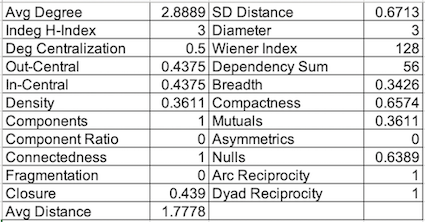
Internally the Santillan cell had a mid-range centralization score of .5 (table above). The range of a centralization score is 1-0 with one being all ties centralized through one actor. The network’s density of .36 may appear low, but for dark networks this is actually a fairly high-density score according to Oliver, though density should be taken with a grain of salt given it is difficult to compare it across networks as Cunningham et. al points out. Thus, average degree is a more useful metric as Cunningham et. al describe. The table above demonstrates an average degree of 2.89 which is high given the size of the 6-7 person cell (unnamed co-conspirator adds to the 6 indicted). Within the cell there was little attempt made to avoid law enforcement or use cut outs. However, the cells contacts with CJNG representatives or brokers may have been far more limited, though we have no doubt LE will have further prosecutions over time. Kathryn Oliver, “Covert Networks: Structures, Processes and Types.” Mitchell Centre Working Paper. 25 June 2014: p. 8, https://hummedia.manchester.ac.uk/schools/soss/research/mitchell/covertnetworks/wp/working_paper1.pdf and Daniel Cunningham, Sean Everton, and Philip Murphy. Understanding Dark Networks: A Strategic Framework for the Use of Social Network Analysis. London: Rowman & Littlefield, 2016.
[22] Op. cit. Baker and Faulkner, at Note 15. p. 853.
[23] David Gagne, “Clandestine Arms Factories Discovered in Mexico,” Insight Crime, 8 October 2014, http://www.insightcrime.org/news-briefs/first-arms-manufacturing-lab-discovered-in-mexico.
[24] Op cit. Leuprecht and Aulthouse at Note 14. p. 66.
[25] Nathan P. Jones, “Bacterial Conjugation as a Framework for the Homogenization of Tactics in Mexican Organized Crime.” Studies in Conflict & Terrorism. Vol. 44, no. 10. 2021: pp. 855–884. https://doi.org/10.1080/1057610X.2019.1586356.
[26] See “Arrests in Los Angeles in Crackdown on Jalisco Drug Cartel.” City News Service via NBC 4 Los Angeles, 11 March 2020, https://www.nbclosangeles.com/news/national-international/jalisco-cartel-arrests-los-angeles/2327353/ and “DEA-led operation nets more than 600 arrests targeting Cártel de Jalisco Nueva Generación,” Press Release. Los Angeles: Drug Enforcement Administration. 11 March 2020, https://www.dea.gov/press-releases/2020/03/11/dea-led-operation-nets-more-600-arrests-targeting-cartel-de-jalisco-nueva.
For Additional Reading
Ioan Grillo, Blood Gun Money: How America Arms Gangs and Cartels. New York: Bloomsbury Publishing, 2021.
Global Study on Firearms Trafficking 2020. United Nations Office on Drugs and Crime (UNDOC). New York: United Nations, 2020.
Nathan Jones, “Appendix A: Goat Horns, Blackbirds, and Cop Killers: U.S. Guns in Mexico’s Drug Violence,” in Sydney Weintraub and Duncan Wood, Eds., Mexico’s Drug Violence in Cooperative Mexican-U.S. Antinarcotics Efforts, Washington, DC: Center for Strategic and International Studies. 2010, pp. 52–73.
John P. Sullivan and Robert J. Bunker, Eds., Strategic Notes on Third Generation Gangs. Bloomington: Xlibris, 2020.







